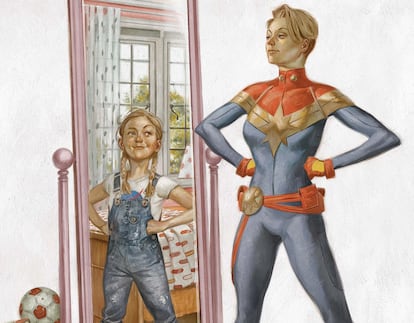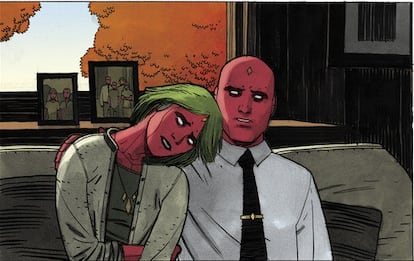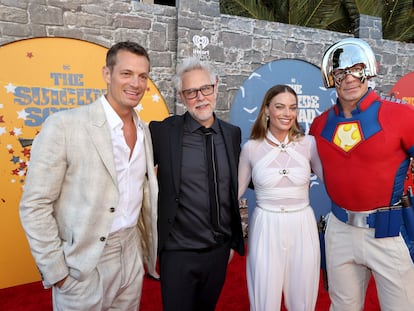Batman’s drinking, Captain Marvel has anxiety, and Hawkeye is on the couch: Superheroes are doing much more than just saving the world
Recent projects like ‘C.O.W.L.’, which focuses on the labor struggle of people with superpowers, put a spotlight on the myriad comics changing up the standard storylines of Marvel and DC icons

What bizarre ideas. The Marvel brass couldn’t believe it: this pair of “oddball” artists had gone too far. Nonetheless, one editor, Stephen Wacher, insisted on defending them. And on giving them a chance. Finally, the upper ranks agreed to publish five of their comics. Not one more: the series would be cancelled right after. It’s not like Hawkeye had exactly been a triumph up to this point. Even if the avenger would now be facing evictions instead of supervillains, spend time depressed on his couch or give up the limelight to his dog, things could hardly get worse. David Aja, the co-author who launched this comic alongside Matt Fraction in 2012, still chuckles at the memory of their journey. The funniest part has to be its epilogue: “As soon as the first album came out, it was a bestseller.”
With the passage of time, it’s also become a role model. A commercial and critical success. And it proves that their skintight costumes need not hold backstories of superheroes. They can join together to form a union and fight through paperwork, as in the recent C.O.W.L. (by Kyle Higgins, Alec Siegel and Rod Reis), which comic book publisher Norma has compared to the series The Wire. Or, they can face down accusations of genocide and sensationalist headlines, as in Strange Adventures (by Tom King, Evan Shaner and Mitch Gerards). “More than a genre, it’s a supergenre, one that naturally integrates trends and aesthetics,” says Santiago García, scriptwriter responsible for the strange twists and turns of El Vecino (The Neighbor) and García! (by Pepo Pérez and Luis Bustos).
When the world is in danger they must save it, of course. But their powers don’t protect them from more human battles: traumas, frustrations, friends, romances, or plain old boredom. Perhaps Kamala Khan spends more time dealing with her adolescence than wondrous peril in Ms. Marvel: No Normal (by G. Willow Wilson and Adrian Alphona). Even the very feats that have brought fame to these icons seem fresh when presented from another perspective: that of the anonymous criminal who follows the Joker (Brian Azzarello and Lee Bermejo) or that of the photographer who crosses paths with the icons and immortalizes them in Marvels (Kurt Busiek and Alex Ross).
“I like to define them as comics about people doing things. They can’t be superheroes all the time, every once in a while they have to drink a cup of coffee, turn on the TV, listen to music…,” Carlos Pacheco, who died last year, explained in this publication back in 2015. He drew a picture of a Carol Danvers suffering from anxiety and a violent father in The Life of Captain Marvel (by Marguerite Sauvage and Margaret Stohl). “In many comics I’ve tried to reverse the proportions. I prefer that the character be doing mundane things 90% of the time. If a horror movie is full of scares, you get used to them, the same goes for a hero who spends 19 out of 20 pages flying or fighting. If he only does that on one page, suddenly it’s more strange and anomalous,” says Gabriel Hernández Walta, who alongside Tom King created another strange superhero story: El Visión (Vision). Or, as the writer put it according to the Spaniard, “I’m going to make the strangest proposal I can think of and see what happens.”
As it so happened, the applause was deafening. And to this day, it’s cited as a model of creative freedom. Although at the same time, it’s an exception. “I still read a lot of monthly superhero comics, and in the majority, months can practically go by without the characters taking their mask off,” says García. At the same time, the authors interviewed for this article mentioned a number of oddball masterpieces throughout history. And they agree on one point: there have always been comics about powerful characters that don’t only focus on their gift and duty to humanity. Or, that dared to look in another direction.
“I’m more interested in the part where they’re walking around their house. A Wolverine who is heartbroken that his love for Jean Grey is not returned. Or Storm turned punk from an existential crisis. Almost all of them have suffered a loss that helps to make them an empathetic character, and more so these days when we are all trying to understand ourselves better with psychologists and self-care,” says Ana Murillo Yagüe, who signs her superhero drawings as Aneke. The names that come up the most are those of Frank Miller (Daredevil, Born Again and The Dark Knight Returns) and Alan Moore (Swamp Thing and Watchmen). But various conversations also mention the 1970s Green Lantern saga by Denny O’Neil and Neal Adams, and the Grant Morrison (for his Animal Man, All Star Superman and Fantastic Four: 1234).
García even harkens to the very Marvel origin story, all the way back to the sixties. “What Stan Lee, Jack Kirby and Steve Ditko accomplished did not exactly have to do with any formula. Few people have been freer than those guys, who were reinventing a genre from top to bottom.” These were more fragile heroes, with problems paying the rent, like Peter Parker, or victims of racism, like the X-Men. They moved through a real city, with its skyscrapers, its protests and drug problems. “What attracts us to superheroes is their weakness. Without kryptonite, Superman would not have transcended,” says comic book artist David Rubín, who reinterprets Greek myth with a modern, personal tone in El héroe (The Hero). “I was able to do it because it was Hercules. Would it have worked with Superman? Of course. Now, would they have let me go as far as I did? No way,” he says.
On this point there is also consensus. Marvel and DC monitor every millimeter of their legends’ journeys. And their executives are not exactly the best allies to creative risk. “Normally, I always have the last word. But here, that falls to DC. And I understand why it has to be like that: they give you one of their very valuable characters for you to play with for a while, and you have to give him back in perfect condition,” he told Paco Roca for this publication in 2021. He’s referring to Batman en Benidorm (Batman in Benidorm), in which Bruce Wayne faces unprecedented enemies: hangover and boredom.
“And he was able to play for real, because of who he was. I haven’t really gotten that chance yet. The characters are loaned to you. And I sell my art. As much as it excites you, you do your bit, but it’s never going to be yours,” says Aneke. Although throughout the years, creators have found their own paths. And they find workarounds for the rigidity of some of the suits: above all, they sharpen their wits, “a bit, with some differences, like the resistance to Franco’s censorship,” clarifies Rubín. But also, they find and maintain like-minded creative partners, to build solidarity in the face of these problems. Or, take advantage of growing prestige to push the envelope further and further. “I’ve noticed that my rising profile as an artist has allowed me to choose between jobs,” says Jorge Fornés, who teamed with Tom King to co-write the highly innovative Rorschach, from the Watchmen universe. So much so that today, he laughingly boasts about his title as the “superhero cartoonist who doesn’t draw superheroes.” That is to say, of panels in which one might expect to see costumes, cosmic rays or punches, which are made all the more conspicuous by their absence.
The truth is that it seems easier to innovate from the margins. Or, to put it differently, away from the spotlight. “I’ve always identified more with Hawkeye, because he’s a bit of a dick. But he also makes us more comfortable doing stories our own way. With Spider-Man and Wonder Woman, there are certain rules,” says Aja. This is also due to their decades of comics, which not only impose a certain essence, but also the challenge to follow, and avoid contradiction of, infinite plot threads. And then there’s the most diehard fans, who sometimes “don’t even want their idol’s bangs to be changed,” according to Rubín. That’s why the most original ideas are usually found in self-contained and independent miniseries, like Spiderman: Life Story or Superman: Red Son.

“There is something that defines these characters, if you want to change them that much you should create a new one,” says Walta. That’s what Pacheco did: together with Kurt Busiek he created Arrowsmith, a superhero plot that blends magic with the horrors of the First World War, whose second installment was just published. Series like Battling Boy and Black Hammer demonstrate roads that could be taken by the legacy icons of Marvel and DC. Another option, of course, would be that the bosses of the big companies learn their lesson. Or, that they don’t end up learning the wrong moral. “Whenever a more original storyline comes out and it works, it creates a problem: if it’s successful, publishers should give others the same freedom to experiment; but what usually ends up happening is that they try to make copies,” says Aja.
Even when it comes to heroes, at the end of the day, it’s all about the money. And more so in the movie theater, where comic icons are often offered up in their most conservative form, with certain exceptions like Todd Philips’s Joker and James Mangold’s Logan. Every million in play reduces executives’ desire to take risks. And on the flip side, it multiplies the number of filters. Aja found this out for himself: “I did a poster for a new Marvel movie and that’s a whole other story, 500,000 people had to weigh in with their opinion.” Under such conditions, no oddball idea may prosper. No matter how many superpowers it has.
Sign up for our weekly newsletter to get more English-language news coverage from EL PAÍS USA Edition
Tu suscripción se está usando en otro dispositivo
¿Quieres añadir otro usuario a tu suscripción?
Si continúas leyendo en este dispositivo, no se podrá leer en el otro.
FlechaTu suscripción se está usando en otro dispositivo y solo puedes acceder a EL PAÍS desde un dispositivo a la vez.
Si quieres compartir tu cuenta, cambia tu suscripción a la modalidad Premium, así podrás añadir otro usuario. Cada uno accederá con su propia cuenta de email, lo que os permitirá personalizar vuestra experiencia en EL PAÍS.
¿Tienes una suscripción de empresa? Accede aquí para contratar más cuentas.
En el caso de no saber quién está usando tu cuenta, te recomendamos cambiar tu contraseña aquí.
Si decides continuar compartiendo tu cuenta, este mensaje se mostrará en tu dispositivo y en el de la otra persona que está usando tu cuenta de forma indefinida, afectando a tu experiencia de lectura. Puedes consultar aquí los términos y condiciones de la suscripción digital.
More information
Archived In
Últimas noticias
Rowan Atkinson tops Netflix at 70: ‘He’s as funny as ever’
Israeli recognition of Somaliland stirs up the Gulf
Tiger Woods turns 50: Will he continue playing on the PGA Tour or take a back seat?
The surreal journey of James Nnaji, the Barcelona youth player selected in the NBA Draft who ended up in the NCAA
Most viewed
- Oona Chaplin: ‘I told James Cameron that I was living in a treehouse and starting a permaculture project with a friend’
- Reinhard Genzel, Nobel laureate in physics: ‘One-minute videos will never give you the truth’
- Sinaloa Cartel war is taking its toll on Los Chapitos
- Why the price of coffee has skyrocketed: from Brazilian plantations to specialty coffee houses
- Chevy Chase, the beloved comedian who was a monster off camera: ‘Not everyone hated him, just the people who’ve worked with him’











































